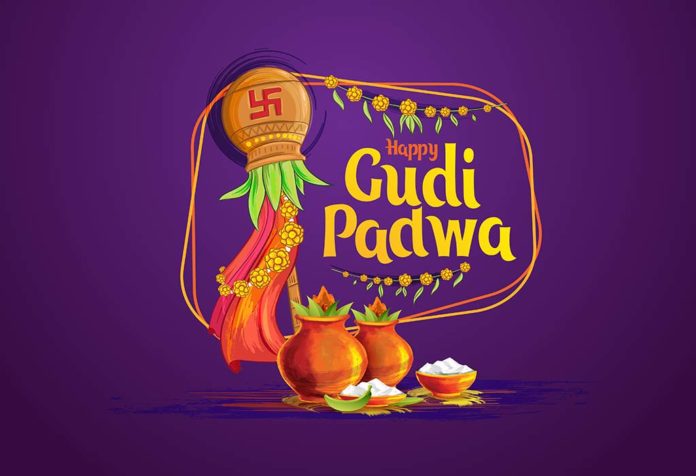Significance of Gudi Padwa
In India, there are festivals celebrated almost every month, in some part of the country or the other. Gudi Padwa is celebrated in the states of Maharashtra and the Konkan region, i.e. in Goa, where it is called Saṁsāra Pāḍavo.
It is celebrated as the New Year, as per the Hindu lunisolar calendar, by Marathis and Konkanis falls on the first day of Chaitra Shukla Paksha (waxing moon). It also marks the lovely season Vasant or Spring and the harvest season, which is very important as India is known as an country which is rich in agriculture.
However, it is important to know that it is not the universal Hindu Year, though the same is celebrated by different names in India, like, Ugadi (Yugadi) is the New Year’s Day for the Hindus of Andhra Pradesh, Telangana and Karnataka states, in Kashmir it is referred to as Navreh and celebrated by the Kashmiri Pandits etc.
Gudi Padwa 2020
On 25th. March, Wednesday, Gudi Padwa 2020 is going to be celebrated in Maharashtra and Konkan region.
Prtipada Tithi Begins – 14:57 (24 March 2020)
Prtipada Tithi Ends – 17:26 (25 March 2020)
There are many stories associated to Gudi Padwa which contribute to the significance of Gudi Padwa. One of the stories linked to Gudi Padwas is that the Universe was destroyed by a massive deluge and on this day of Gudi Padwa, Lord Brahma, the Creator, recreated the Universe again.
The other important legend is about Lord Ram’s coming back to Ayodhya after slaying Ravana. It is said that the flag or ‘Gudi’ which is hoisted in every Marathi house on this day is to celebrate His happy return. Lord Ram is an avatar of Lord Vishnu and so Lord Vishnu is worshipped on this day for His blessings.
Things to do on Gudi Padwa
This auspicious day of Gudi Padwa is about new beginnings.
On the day of Gudi Padwa people have an early morning bath, the village’s people take a dip in the nearby river. Some devotees get up and bathe before dawn to try to imbibe the purity of the Sun. New clothes are worn. Women wear traditional jewellery and saree.
Unlike other festivals where sweet eating is popular, Gudi Padwa starts with having a bitter-sweet-sour mixture of Neem leaves, Tamarind pulp and jaggery.
Beautiful Rangolis are drawn outside the main entrance to invite the blessings of abundance and prosperity, with colour powder and flower petals.
Houses have Mango leaf Yellow flower combination Toran decorations is hung outside their main entrance of the house, which is considered auspicious.
The hoisting of the Gudi or ‘Brahma Dhwaja’ is an important ritual of Gudi Padwa and every Maratha house has the Gudi installed outside their main entrance, a ritual said to have been started by Chattrapati Shivaji Maharaj.
It is installed as per the Tithi after Sunrise. The Gudi is assembled by the members of the family. Traditionally the Gudi is a clean long Bamboo stick, with a Yellow or Green cloth with Zari or Brocade work on the border, tied on the top end.
Over the cloth, Mango and Neem leaves, Marigold flower garland and a garland made of special Marathi sugar crystal is tied. Then a Silver or Copper pot is inverted over all this at the top.
Generally it is hoisted by the senior most outside the main entrance of the house ensuring that it is held high after installing so that it is seen from far and near.
It brings in happy, victorious and prosperous energies to the house. At the time of sunset the Gudi should be lowered after offering jaggery as Naivedya.
Lord Brahma and Lord Vishnu are worshipped by members of family, Homa or Havan is performed. Visiting temples with offerings of sweets, flowers etc. is also common.
It is a day to have special and delicious food preparations like Puran Poli, Puri with Shrikhand, sweet Rice etc. The meals are often had together with relatives and friends. It is a day where the relationships are strengthened by meeting and sharing gifts and food.
Also Read: one punch man season 3
Among the things to do on Gudi Padwa,is also the tradition of buying gold as it is an auspicious day, which symbolizes prosperity, buying a new car is common.
New business ventures are started, shops are inaugurated, new houses are bought and many who have bought new house choose to do their house warming this day. All kinds of new beginnings are blessed.
The fun continues in the evening with people watching traditional Marathi dance performances organized for that day or visit house of friends and family and entertain guests.
Also Read – Celebrated Gudi Padwa or Marathi New Year


